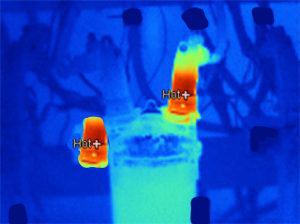Do you know what a “hot spot” is? And no, it  doesn’t refer to the latest after-hours club or newest restaurant opening. A hot spot, when found in your home, could mean you have a serious problem.
doesn’t refer to the latest after-hours club or newest restaurant opening. A hot spot, when found in your home, could mean you have a serious problem.
What is a Hot Spot?
Hot spots are areas characterized by a noticeably-higher temperature in one spot when compared to its surroundings. They can be found in walls, ceilings, floors, or around appliances and are most commonly caused by electrical problems; for example, by faulty or malfunctioning electrical circuits, wires or outlets. Electrical issues not detected and resolved in a timely manner may lead to appliance breakdown or even worse—a fire.
The Problem with Hot Spots
The biggest problem is that hot spots are not visible to the naked eye. That means you could purchase or be already living in a seemingly-perfect house without being aware of a hot spot until it causes damage to your property. Similarly, a home inspector performing a simple visual assessment of your home would not be able to locate them.
A Thermal Imaging Inspection Can Detect Hot Spots
Thermal imaging has taken home inspections to the next level, allowing you and your inspector to “see” beneath the surface of your house to discover the true condition of your property. It is a state-of-the-art, non-invasive technology that lets a home inspector easily scan for any anomalies caused by excessive thermal heat, giving the inspector results that can be translated into an actionable plan.
With thermal imaging, our home inspector can locate hot spots caused by anything from overheated electrical equipment and overloaded circuits to missing or faulty insulation and electrical faults. The inspection can detect issues caused by faulty construction behind walls or under floors.
How Does Thermal Imaging Work?
Thermal imaging is a technique used to produce images of the infrared energy emitted from objects in order to detect specific areas of abnormally-high temperatures. It identifies problems with electrical, mechanical or other systems inside your home, allowing you to react before the issue becomes more serious.
Through the use of thermographic cameras, which look like your average large camera, images called thermograms are produced based on detected infrared radiation. The images first appear in grayscale images, which are then converted to color images for easier interpretation.
Other Uses for Thermal Imaging
Thermal imaging can also be used to find cold spots caused by excessive moisture or areas of abnormal heat loss, or areas of inconsistency in temperatures. It can even discover pest infestations.
Do You Have Hot Spots?
Like any type of home inspection, thermal imaging cannot predict future problems, however, it can precisely pinpoint hot spots in your home, providing you with accurate information needed to take appropriate repair or improvement measures.
Thermal imaging can also be an incredibly useful tool for home buyers who want to make sure the house they are considering to buy is in good condition and doesn’t pose any safety risks.
Contact Först Consulting Group
Thermal imaging is one of the advanced technologies Först Consulting Group uses to provide comprehensive service to our clients. We work with existing homeowners and those looking at a particular house to purchase.
Although we are not your normal home inspector, we do provide specialized home inspections including Building Pathology Inspection, Construction Defect Inspection, Pre-Drywall Inspection, Stucco Inspection, Thermal Inspection, and Private Pre-Sale Home Inspection. If you suspect a hot spot or would like a complete or partial home inspection, please contact us today to set your appointment.




